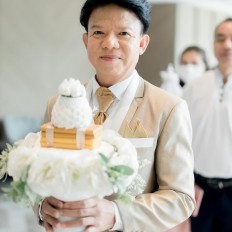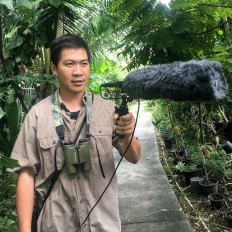Khao Yai National Park 2 hours drive NorthEast of Bangkok draws over 1 million visitors annually.
No wonder they park fee is held up to 400Baht a person as it is bringing in lots of revenue to the Forestry Department. 200 for children (these are foreign rates, locals are 10 times lower)
The park was founded in 1962 as the first National Park in the Kingdom. It is about 2200 square km and borders 4 provinces. Most of the park is on an elevation of 7-900m but it is possible to get up to 11-1200m. Seeing that the forest is pretty homogenus birdlife is not all that different throughout the park but varies mostly dependant on amount of water accessability.
The park is a forest island surrounded by farmed lowland. Wildlife is thus confined to the park boundaries (and KY is also connected to Thap Lun and Pang Sida National Parks which furter extends the forest complex).
In times past tigers were seen near Headquarters but they have retreated to the most remote areas of the park and no longer seen in touristy areas. However elephants are aboundant and often come walking on the road. Gibbons, Long-tailed Macaques, Sambar and Barking deer are all common. At night civets, porcupines and even small felines can be found.
The weather is very pleasant in the dry season (Nov-Mar) and can drop below 10C.
There are many highly sought after birds in the park: Coral-billed Ground-Cuckoo, Silver Pheasant, Siamese Fireback, Eared Pitta, Brown Hornbill (Austen's), Blue Pitta, forktails, trogons, broadbills, hornbills, bulbuls, drongos, flycatchers, babblers etc.
The park is quiet varied and criss crossed with paved roads (in the core visiting area that is). There are many spots to do and many trails to walk if one wants to. (trails when wet can be infested with leaches).
There are many snakes in the park but you would be lucky to see one.
Due to heavy traffic (many peole live within the park, military, park rangers and their families, research units, fire-station, and inspite of many speed bumbs many vehicles drive quite fast).
Also motorcycles are allowed so once in a while a group of bikers will show up.
Many other people come to ride their bicycles.
It is not allowed to park on the roadside except there is a proper pull over.
Khao Yai, as busy as it can get, still provides a great wildlife experience and especially if you are not hurried but take time to go slow and be observant.
For more info:
https://whc.unesco.org/en/list/590/
Khao Yai National Park 2 hours drive NorthEast of Bangkok draws over 1 million visitors annually.
No wonder they park fee is held up to 400Baht a person as it is bringing in lots of revenue to the Forestry Department. 200 for children (these are foreign rates, locals are 10 times lower)
The park was founded in 1962 as the first National Park in the Kingdom. It is about 2200 square km and borders 4 provinces. Most of the park is on an elevation of 7-900m but it is possible to get up to 11-1200m. Seeing that the forest is pretty homogenus birdlife is not all that different throughout the park but varies mostly due to access to dependant on amount of water or not.
accessability.
The park is a forest island surrounded by farmed lowland. Wildlife is thus confined to the park boundaries (and KY is also connected to Thap Lun and Pang Sida National Parks which furter extends the forest complex).
In times past tigers were seen near Headquarters but they have retreated to the most remote areas of the park and no longer seen in touristy areas. However elephants are aboundant and often come walking on the road. Gibbons, Long-tailed Macaques, Sambar and Barking deer are all common. At night civets, porcupines and even small fellines felines can be found.
The weather is very pleasant in the dry season (Nov-Mar) and can drop below 10C.
There are many highly sought after birds in the park: Coral-billed Ground-Cuckoo, Silver Pheasant, Siamese Fireback, Eared Pitta, Brown Hornbill (Austen's), Blue Pitta, forktails, trogons, broadbills, hornbills, bulbuls, drongos, flycatchers, babblers etc.
The park is quiet varied and criss crossed with paved roads (in the core visiting area that is). There are many spots to do and many trails to walk if one wants to. (trails when wet can be infested with leaches).
There are many snakes in the park but you would be lucky to see one.
Due to heavy traffic (many peole live within the park, military, park rangers and their families, research units, fire-station, and inspite of many speed bumbs many vehicles drive quite fast.
fast).
Also motorcycles are allowed so once in a while a group of bikers will show up.
Many other people come to ride their bicycles.
It is not allowed to park on the roadside except there is a proper pull over.
Khao Yai, as busy as it can get, still provides a great wildlife experience and especially if you are not hurried but take time to go slow and be observant.
For more info:
https://whc.unesco.org/en/list/590/
Khao Yai National Park 2 hours drive NorthEast of Bangkok draws over 1 million visitors annually.
No wonder they park fee is held up to 400Baht a person as it is bringing in lots of revenue to the Forestry Department. 200 for children (these are foreign rates, locals are 10 times lower)
The park was founded in 1962 as the first National Park in the Kingdom. It is about 2200 square km and borders 4 provinces. Most of the park is on an elevation of 7-900m but it is possible to get up to 11-1200m. Seeing that the forest is pretty homogenus birdlife is not all that different throughout the park but varies mostly due to access to water or not.
The park is a forest island surrounded by farmed lowland. Wildlife is thus confined to the park boundaries (and KY is also connected to Thap Lun and Pang Sida National Parks which furter extends the forest complex).
In times past tigers were seen near Headquarters but they have retreated to the most remote areas of the park and no longer seen in touristy areas. However elephants are aboundant and often come walking on the road. Gibbons, Long-tailed Macaques, Sambar and Barking deer are all common. At night civets, porcupines and even small fellines can be found.
The weather is very pleasant in the dry season (Nov-Mar) and can drop below 10C.
There are many highly sought after birds in the park: Coral-billed Ground-Cuckoo, Silver Pheasant, Siamese Fireback, Eared Pitta, Brown Hornbill (Austen's), Blue Pitta, forktails, trogons, broadbills, hornbills, bulbuls, drongos, flycatchers, babblers etc.
The park is quiet varied and criss crossed with paved roads (in the core visiting area that is). There are many spots to do and many trails to walk if one wants to. (trails when wet can be infested with leaches).
There are many snakes in the park but you would be lucky to see one.
Due to heavy traffic (many peole live within the park, military, park rangers and their families, research units, fire-station, and inspite of many speed bumbs many vehicles drive quite fast.
It is not allowed to park on the roadside except there is a proper pull over.
Khao Yai, as busy as it can get, still provides a great wildlife experience and especially if you are not hurried but take time to go slow and be observant.
https://whc.unesco.org/en/list/590/
Khao Yai National Park 2 hours drive NorthEast of Bangkok draws over 1 million visitors annually.
No wonder they park fee is held up to 400Baht a person as it is bringing in lots of revenue to the Forestry Department. 200 for children (these are foreign rates, locals are 10 times lower)
The park was founded in 1962 as the first National Park in the Kingdom. It is about 2200 square km and borders 4 provinces. Most of the park is on an elevation of 7-900m but it is possible to get up to 11-1200m. Seeing that the forest is pretty homogenus birdlife is not all that different throughout the park but varies mostly due to access to water or not.
The park is a forest island surrounded by farmed lowland. Wildlife is thus confined to the park boundaries (and KY is also connected to Thap Lun and Pang Sida National Parks which furter extends the forest complex).
In times past tigers were seen near Headquarters but they have retreated to the most remote areas of the park and no longer seen in touristy areas. However elephants are aboundant and often come walking on the road. Gibbons, Long-tailed Macaques, Sambar and Barking deer are all common. At night civets, porcupines and even small fellines can be found.
The weather is very pleasant in the dry season (Nov-Mar) and can drop below 10C.
There are many highly sought after birds in the park: Coral-billed Ground-Cuckoo, Silver Pheasant, Siamese Fireback, Eared Pitta, Brown Hornbill (Austen's), Blue Pitta, forktails, trogons, broadbills, hornbills, bulbuls, drongos, flycatchers, babblers etc.
The park is quiet varied and criss crossed with paved roads (in the core visiting area that is). There are many spots to do and many trails to walk if one wants to. (trails when wet can be infested with leeches).
leaches).
There are many snakes in the park but you would be lucky to see one.
Due to heavy traffic (many peole live within the park, military, park rangers and their families, research units, fire-station, and inspite of many speed bumbs many vehicles drive quite fast.
It is not allowed to park on the roadside except there is a proper pull over.
Khao Yai, as busy as it can get, still provides a great wildlife experience and especially if you are not hurried but take time to go slow and be observant.
Khao Yai National Park 2 hours drive NorthEast of Bangkok draws over 1 million visitors annually.
No wonder they park fee is held up to 400Baht a person as it is bringing in lots of revenue to the Forestry Department. 200 for children (these are foreign rates, locals are 10 times lower)
The park was founded in 1962 as the first National Park in the Kingdom. It is about 2200 square km and borders 4 provinces. Most of the park is on an elevation of 7-900m but it is possible to get up to 11-1200m. Seeing that the forest is pretty homogenus birdlife is not all that different throughout the park but varies mostly due to access to water or not.
The park is a forest island surrounded by farmed lowland. Wildlife is thus confined to the park boundaries (and KY is also connected to Thap Lun and Pang Sida National Parks which furter extends the forest complex).
In times past tigers were seen near Headquarters but they have retreated to the most remote areas of the park and no longer seen in touristy areas. However elephants are aboundant and often come walking on the road. Gibbons, Long-tailed Macaques, Sambar and Barking deer are all common. At night civets, porcupines and even small fellines can be found.
There are many highly sought after birds in the park: Coral-billed Ground-Cuckoo, Silver Pheasant, Siamese Fireback, Eared Pitta, Brown Hornbill (Austen's), Blue Pitta, forktails, trogons, broadbills, hornbills, bulbuls, drongos, flycatchers, babblers etc.
The park is quiet varied and criss crossed with paved roads (in the core visiting area that is). There are many spots to do and many trails to walk if one wants to. (trails when wet can be infested with leeches).
Due to heavy traffic (many peole live within the park, military, park rangers and their families, research units, fire-station, and inspite of many speed bumbs many vehicles drive quite fast.
It is not allowed to park on the roadside except there is a proper pull over.
Khao Yai, as busy as it can get, still provides a great wildlife experience and especially if you are not hurried but take time to go slow and be observant.




